Abstract
Male and female BALB/c mice were inoculated with various concentrations of coxsackievirus, group B, type 3 (CVB3), ranging from 10 to 10(7) plaque-forming units (PFU). Lower viral doses (greater than 10(2) PFU) induced severe myocarditis in male mice but caused little injury in females. With 10(7) PFU, females also developed severe disease. Females may be relatively resistant to CVB3-induced myocarditis because virus entry into the blood and heart is less effective. Males given 125I-CVB3 show approximately 2-4 and 20-fold more radioactivity in the peripheral blood and heart, respectively, than females. No differences were observed between the sexes in 125I-bovine serum albumin penetration. Sex steroid hormones influence viremia and virus localization; females given exogenous testosterone and progesterone demonstrate ten times more virus in their hearts than animals given estradiol. The hormones may act by increasing virus receptor expression on endothelial cells and myocytes.
Full text
PDF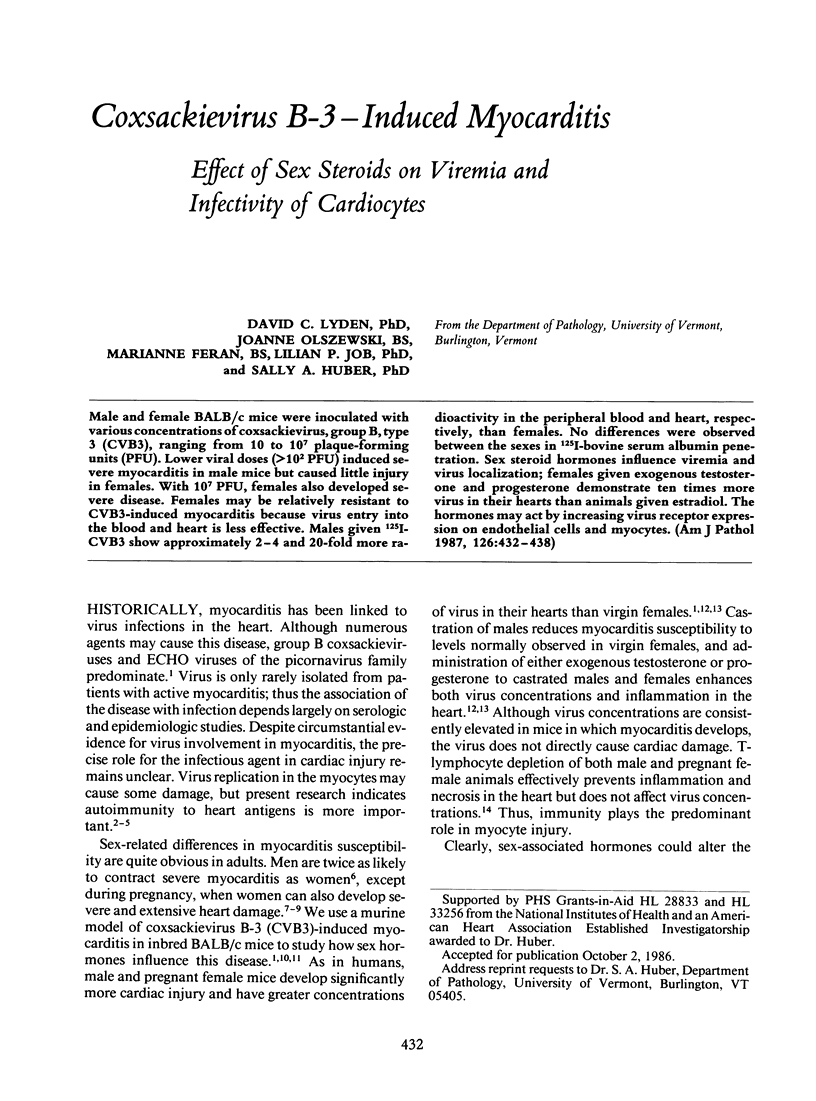

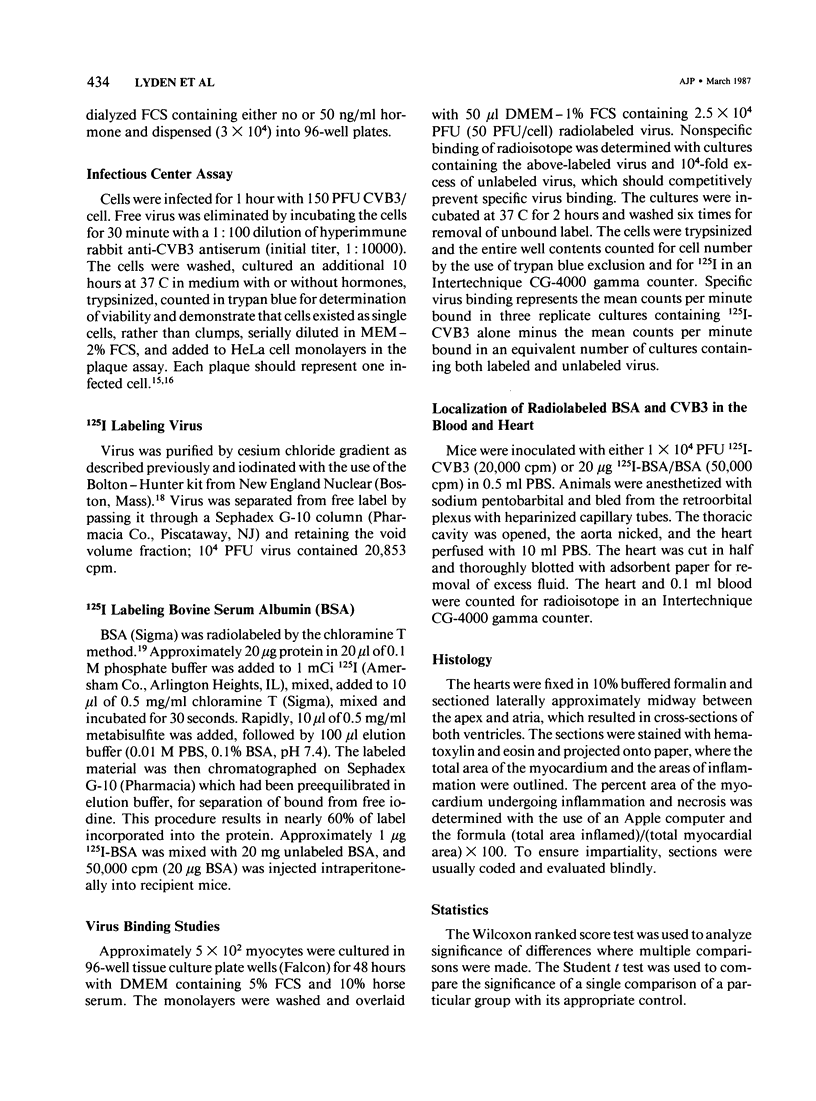
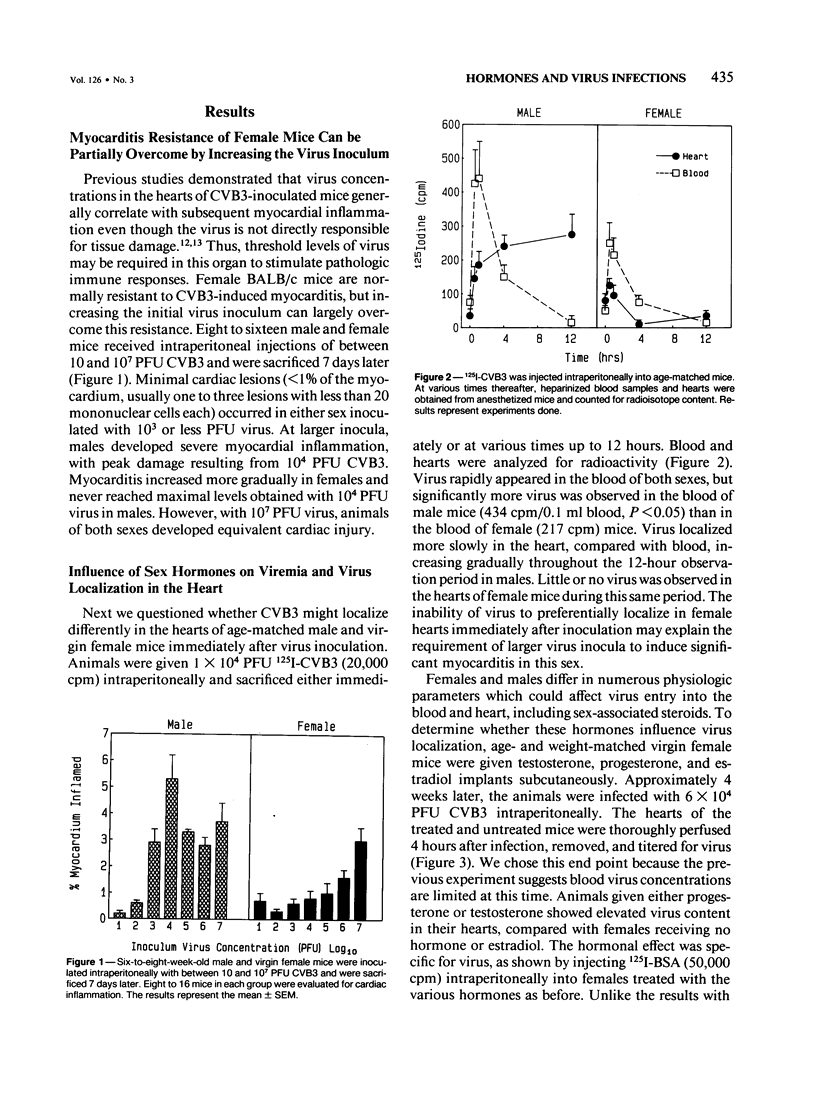
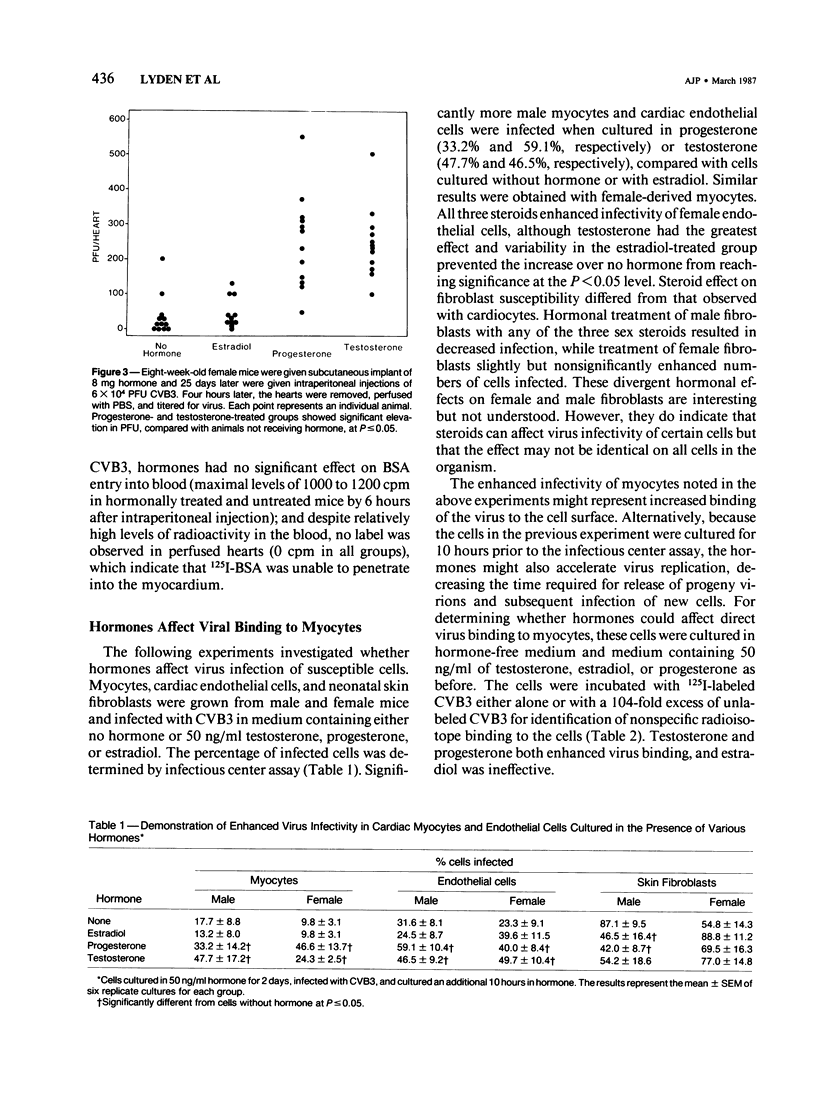
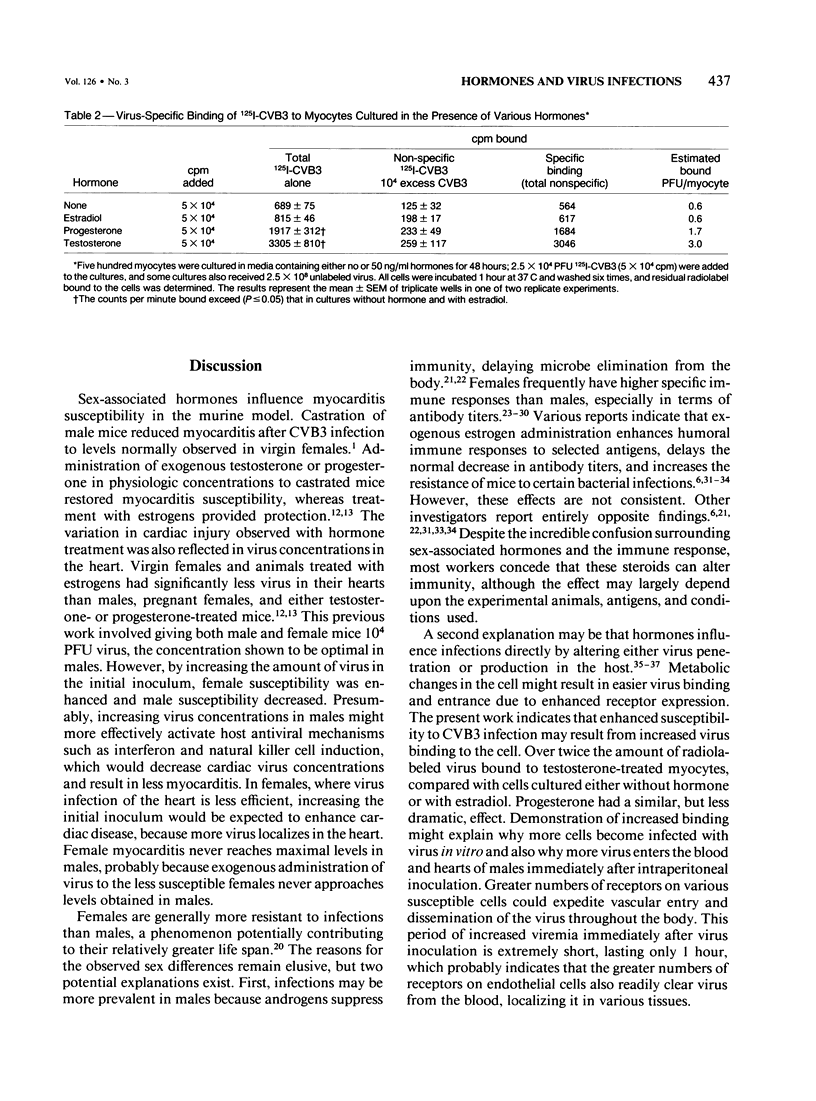
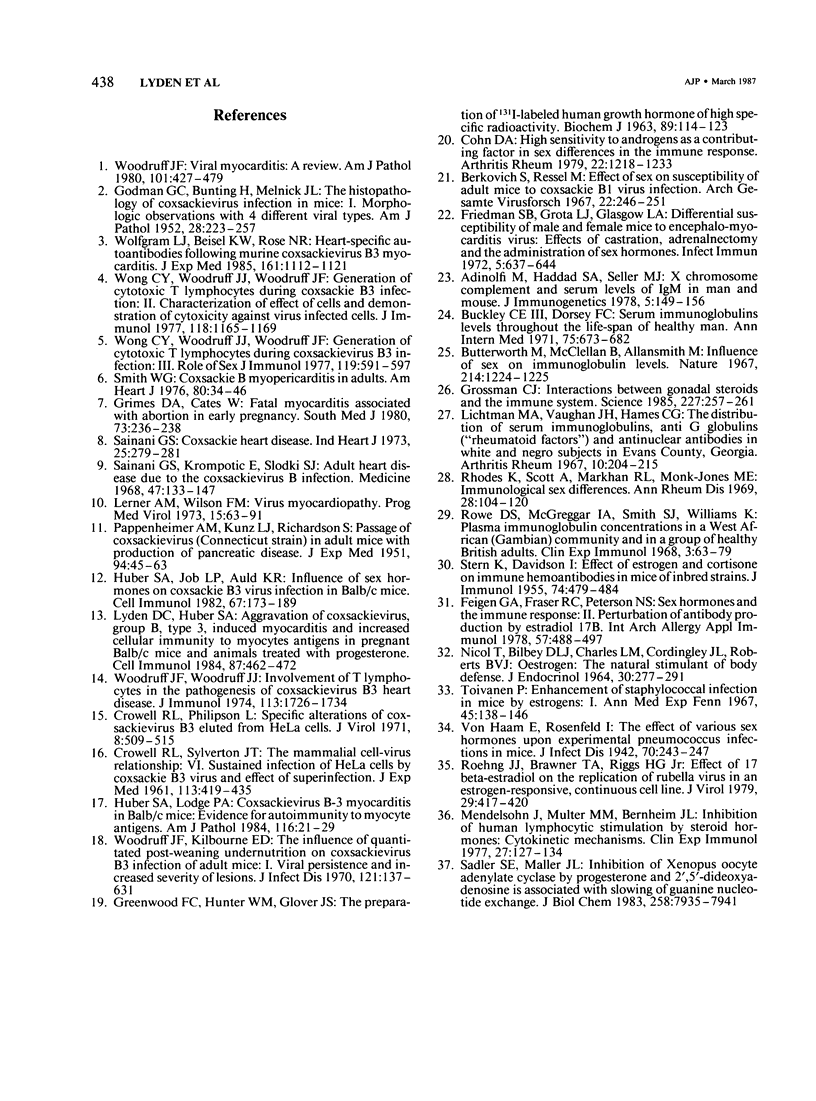
Selected References
These references are in PubMed. This may not be the complete list of references from this article.
- Adinolfi M., Haddad S. A., Seller M. J. X chromosome complement and serum levels of IgM in man and mouse. J Immunogenet. 1978 Jun;5(3):149–156. doi: 10.1111/j.1744-313x.1978.tb00640.x. [DOI] [PubMed] [Google Scholar]
- Berjivich S., Ressel M. Effect of sex on susceptibility of adult mice to coxsackie B1 virus infection. Arch Gesamte Virusforsch. 1967;22(1):246–251. doi: 10.1007/BF01240519. [DOI] [PubMed] [Google Scholar]
- Buckley C. E., 3rd, Dorsey F. C. Serum immunoglobulin levels throughout the life-span of healthy man. Ann Intern Med. 1971 Nov;75(5):673–682. doi: 10.7326/0003-4819-75-5-673. [DOI] [PubMed] [Google Scholar]
- Butterworth M., McClellan B., Allansmith M. Influence of sex in immunoglobulin levels. Nature. 1967 Jun 17;214(5094):1224–1225. doi: 10.1038/2141224a0. [DOI] [PubMed] [Google Scholar]
- CROWELL R. L., SYVERTON J. T. The mammalian cell-virus relationship. VI. Sustained infection of HeLa cells by Coxsackie B3 virus and effect on superinfection. J Exp Med. 1961 Feb 1;113:419–435. doi: 10.1084/jem.113.2.419. [DOI] [PMC free article] [PubMed] [Google Scholar]
- Cohn D. A. High sensitivity to androgen as a contributing factor in sex differences in the immune response. Arthritis Rheum. 1979 Nov;22(11):1218–1233. doi: 10.1002/art.1780221109. [DOI] [PubMed] [Google Scholar]
- Crowell R. L., Philipson L. Specific alterations of coxsackievirus B3 eluted from HeLa cells. J Virol. 1971 Oct;8(4):509–515. doi: 10.1128/jvi.8.4.509-515.1971. [DOI] [PMC free article] [PubMed] [Google Scholar]
- Feigen G. A., Fraser R. C., Peterson N. S. Sex hormones and the immune response. II. Perturbation of antibody production by estradiol 17beta. Int Arch Allergy Appl Immunol. 1978;57(6):488–497. doi: 10.1159/000232143. [DOI] [PubMed] [Google Scholar]
- Friedman S. B., Grota L. J., Glasgow L. A. Differential susceptibility of male and female mice to encephalomyocarditis virus: effects of castration, adrenalectomy, and the administration of sex hormones. Infect Immun. 1972 May;5(5):637–644. doi: 10.1128/iai.5.5.637-644.1972. [DOI] [PMC free article] [PubMed] [Google Scholar]
- GODMAN G. C., BUNTING H., MELNICK J. L. The histopathology of Coxsackie virus infection in mice. I. Morphologic observations with four different viral types. Am J Pathol. 1952 Mar-Apr;28(2):223–257. [PMC free article] [PubMed] [Google Scholar]
- GREENWOOD F. C., HUNTER W. M., GLOVER J. S. THE PREPARATION OF I-131-LABELLED HUMAN GROWTH HORMONE OF HIGH SPECIFIC RADIOACTIVITY. Biochem J. 1963 Oct;89:114–123. doi: 10.1042/bj0890114. [DOI] [PMC free article] [PubMed] [Google Scholar]
- Grimes D. A., Cates W., Jr Fatal myocarditis associated with abortion in early pregnancy. South Med J. 1980 Feb;73(2):236–238. doi: 10.1097/00007611-198002000-00029. [DOI] [PubMed] [Google Scholar]
- Grossman C. J. Interactions between the gonadal steroids and the immune system. Science. 1985 Jan 18;227(4684):257–261. doi: 10.1126/science.3871252. [DOI] [PubMed] [Google Scholar]
- Huber S. A., Job L. P., Auld K. R. Influence of sex hormones on Coxsackie B-3 virus infection in Balb/c mice. Cell Immunol. 1982 Feb;67(1):173–179. doi: 10.1016/0008-8749(82)90210-6. [DOI] [PubMed] [Google Scholar]
- Huber S. A., Lodge P. A. Coxsackievirus B-3 myocarditis in Balb/c mice. Evidence for autoimmunity to myocyte antigens. Am J Pathol. 1984 Jul;116(1):21–29. [PMC free article] [PubMed] [Google Scholar]
- Lerner A. M., Wilson F. M. Virus myocardiopathy. Prog Med Virol. 1973;15:63–91. [PubMed] [Google Scholar]
- Lichtman M. A., Vaughan J. H., Hames C. G. The distribution of serum immunoglobulins, anti-gamma-G globulins ("rheumatoid factors") and antinuclear antibodies in White and Negro subjects in Evans County, Georgia. Arthritis Rheum. 1967 Jun;10(3):204–215. doi: 10.1002/art.1780100306. [DOI] [PubMed] [Google Scholar]
- Lyden D. C., Huber S. A. Aggravation of coxsackievirus, group B, type 3-induced myocarditis and increase in cellular immunity to myocyte antigens in pregnant Balb/c mice and animals treated with progesterone. Cell Immunol. 1984 Sep;87(2):462–472. doi: 10.1016/0008-8749(84)90015-7. [DOI] [PubMed] [Google Scholar]
- Mendelsohn J., Multer M. M., Bernheim J. L. Inhibition of human lymphocyte stimulation by steroid hormones: cytokinetic mechanisms. Clin Exp Immunol. 1977 Jan;27(1):127–134. [PMC free article] [PubMed] [Google Scholar]
- NICOL T., BILBEY D. L., CHARLES L. M., CORDINGLEY J. L., VERNON-ROBERTS B. OESTROGEN: THE NATURAL STIMULANT OF BODY DEFENCE. J Endocrinol. 1964 Oct;30:277–291. doi: 10.1677/joe.0.0300277. [DOI] [PubMed] [Google Scholar]
- PAPPENHEIMER A. M., KUNZ L. J., RICHARDSON S. Passage of Coxsackie virus (Connecticut-5 strain) in adult mice with production of pancreatic disease. J Exp Med. 1951 Jul 1;94(1):45–64. doi: 10.1084/jem.94.1.45. [DOI] [PMC free article] [PubMed] [Google Scholar]
- Rhodes K., Scott A., Markham R. L., Monk-Jones M. E. Immunological sex differences. A study of patients with rheumatoid arthritis, their relatives, and controls. Ann Rheum Dis. 1969 Mar;28(2):104–120. doi: 10.1136/ard.28.2.104. [DOI] [PMC free article] [PubMed] [Google Scholar]
- Roehrig J. T., Brawner T. A., Riggs H. G., Jr Effects of 17beta-estradiol on the replication of rubella virus in an estrogen-responsive, continuous cell line. J Virol. 1979 Jan;29(1):417–420. doi: 10.1128/jvi.29.1.417-420.1979. [DOI] [PMC free article] [PubMed] [Google Scholar]
- Rowe D. S., McGregor I. A., Smith S. J., Hall P., Williams K. Plasma immunoglobulin concentrations in a West African (Gambian) community and in a group of healthy British adults. Clin Exp Immunol. 1968 Jan;3(1):63–79. [PMC free article] [PubMed] [Google Scholar]
- STERN K., DAVIDSOHN I. Effect of estrogen and cortisone on immune hemoantibodies in mice of inbred strains. J Immunol. 1955 Jun;74(6):479–484. [PubMed] [Google Scholar]
- Sadler S. E., Maller J. L. Inhibition of Xenopus oocyte adenylate cyclase by progesterone and 2',5'-dideoxyadenosine is associated with slowing of guanine nucleotide exchange. J Biol Chem. 1983 Jul 10;258(13):7935–7941. [PubMed] [Google Scholar]
- Sainani G. S. Editorial: Coxsackie heart disease. Indian Heart J. 1973 Oct;25(4):279–281. [PubMed] [Google Scholar]
- Sainani G. S., Krompotic E., Slodki S. J. Adult heart disease due to the Coxsackie virus B infection. Medicine (Baltimore) 1968 Mar;47(2):133–147. doi: 10.1097/00005792-196803000-00003. [DOI] [PubMed] [Google Scholar]
- Smith W. G. Coxsackie B myopericarditis in adults. Am Heart J. 1970 Jul;80(1):34–46. doi: 10.1016/0002-8703(70)90035-9. [DOI] [PubMed] [Google Scholar]
- Toivanen P. Enhancement of staphylococcal infection in mice by estrogens. I. Effect of the timing, quantity and quality of the hormone. Ann Med Exp Biol Fenn. 1967;45(2):138–146. [PubMed] [Google Scholar]
- Wolfgram L. J., Beisel K. W., Rose N. R. Heart-specific autoantibodies following murine coxsackievirus B3 myocarditis. J Exp Med. 1985 May 1;161(5):1112–1121. doi: 10.1084/jem.161.5.1112. [DOI] [PMC free article] [PubMed] [Google Scholar]
- Wong C. Y., Woodruff J. J., Woodruff J. F. Generation of cytotoxic T lymphocytes during coxsackievirus B-3 infection. III. Role of sex. J Immunol. 1977 Aug;119(2):591–597. [PubMed] [Google Scholar]
- Wong C. Y., Woodruff J. J., Woodruff J. F. Generation of cytotoxic T lymphocytes during coxsackievirus tb-3 infection. II. Characterization of effector cells and demonstration cytotoxicity against viral-infected myofibers1. J Immunol. 1977 Apr;118(4):1165–1169. [PubMed] [Google Scholar]
- Woodruff J. F., Kilbourne E. D. The influence of quantitated post-weaning undernutrition on coxsackievirus B3 infection of adult mice. I. Viral persistence and increased severity of lesions. J Infect Dis. 1970 Feb;121(2):137–163. doi: 10.1093/infdis/121.2.137. [DOI] [PubMed] [Google Scholar]
- Woodruff J. F., Woodruff J. J. Involvement of T lymphocytes in the pathogenesis of coxsackie virus B3 heart disease. J Immunol. 1974 Dec;113(6):1726–1734. [PubMed] [Google Scholar]


